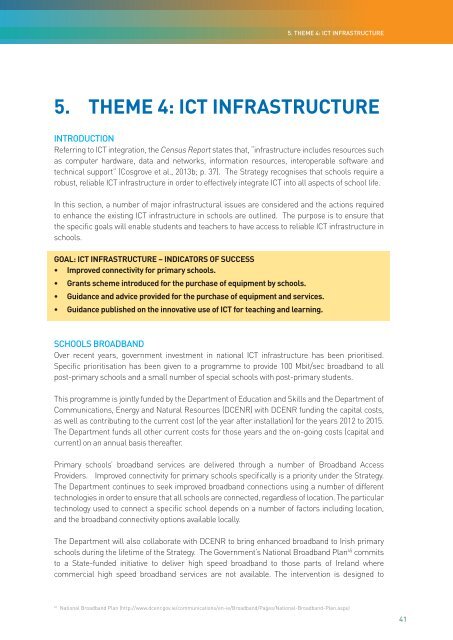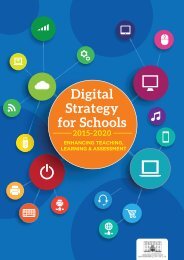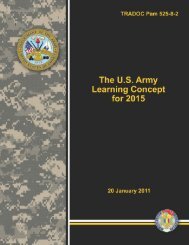Digital Strategy for Schools
TKmc0
TKmc0
You also want an ePaper? Increase the reach of your titles
YUMPU automatically turns print PDFs into web optimized ePapers that Google loves.
5. THEME 4: ICT INFRASTRUCTURE<br />
5. THEME 4: ICT INFRASTRUCTURE<br />
INTRODUCTION<br />
Referring to ICT integration, the Census Report states that, “infrastructure includes resources such<br />
as computer hardware, data and networks, in<strong>for</strong>mation resources, interoperable software and<br />
technical support” (Cosgrove et al., 2013b; p. 37). The <strong>Strategy</strong> recognises that schools require a<br />
robust, reliable ICT infrastructure in order to effectively integrate ICT into all aspects of school life.<br />
In this section, a number of major infrastructural issues are considered and the actions required<br />
to enhance the existing ICT infrastructure in schools are outlined. The purpose is to ensure that<br />
the specific goals will enable students and teachers to have access to reliable ICT infrastructure in<br />
schools.<br />
GOAL: ICT INFRASTRUCTURE – INDICATORS OF SUCCESS<br />
• Improved connectivity <strong>for</strong> primary schools.<br />
• Grants scheme introduced <strong>for</strong> the purchase of equipment by schools.<br />
• Guidance and advice provided <strong>for</strong> the purchase of equipment and services.<br />
• Guidance published on the innovative use of ICT <strong>for</strong> teaching and learning.<br />
SCHOOLS BROADBAND<br />
Over recent years, government investment in national ICT infrastructure has been prioritised.<br />
Specific prioritisation has been given to a programme to provide 100 Mbit/sec broadband to all<br />
post-primary schools and a small number of special schools with post-primary students.<br />
This programme is jointly funded by the Department of Education and Skills and the Department of<br />
Communications, Energy and Natural Resources (DCENR) with DCENR funding the capital costs,<br />
as well as contributing to the current cost (of the year after installation) <strong>for</strong> the years 2012 to 2015.<br />
The Department funds all other current costs <strong>for</strong> those years and the on-going costs (capital and<br />
current) on an annual basis thereafter.<br />
Primary schools’ broadband services are delivered through a number of Broadband Access<br />
Providers. Improved connectivity <strong>for</strong> primary schools specifically is a priority under the <strong>Strategy</strong>.<br />
The Department continues to seek improved broadband connections using a number of different<br />
technologies in order to ensure that all schools are connected, regardless of location. The particular<br />
technology used to connect a specific school depends on a number of factors including location,<br />
and the broadband connectivity options available locally.<br />
The Department will also collaborate with DCENR to bring enhanced broadband to Irish primary<br />
schools during the lifetime of the <strong>Strategy</strong>. The Government’s National Broadband Plan 45 commits<br />
to a State-funded initiative to deliver high speed broadband to those parts of Ireland where<br />
commercial high speed broadband services are not available. The intervention is designed to<br />
45<br />
National Broadband Plan (http://www.dcenr.gov.ie/communications/en-ie/Broadband/Pages/National-Broadband-Plan.aspx)<br />
41




